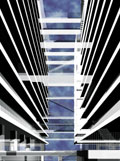Kengo
Kuma & Associates
Kuma (Kengo) (1954)

• New Concept in Public Housing Tokyo, en cours
| (J) | After studying at Tokyo University and spending a year at Columbia University, where he was a resident researcher in 1985-86, Kengo Kuma founded "Kengo Kuma & Associates" in 1990. "Doing away with architecture", or alternatively, eliminating form: such is the goal he claims to be after, in his opposition to object architecture and academicism. This is the sense of Kengo Kuma's interest in architecture, and it is also the sense he is looking for when he questions tradition, be it in a bamboo house, where he makes use of the specific features of a material which, when used, still remains a natural material, or in Noh theatre, the meaning of which he exacerbates, actual nature, in a relationship that is totally open to the landscape; or be it in the Hiroshige Museum, drawing inspiration from the building itself to capture light, or, lastly, in the Canal Kakatami Museum, which he deals with like an artefact in nature, like the canal itself which conjugates natural and artificial. In the collective housing project which he is designing for a suburban neighbourhood of Tokyo, which is almost exclusively residential, he takes the evolution of the family and daily life into account. The very meaning of his proposition lies in the fact that he recreates the street, but an inner street (in the sky), onto which the main housing units and smaller adjoining areas, which may assume different functions, open: from the extra bedroom to the office or shop. It is a three-dimensional street in which people move about from one floor to the next, and from one side to the other, on foot bridges. A Le Corbusier-like "housing unit", but revisited for new lifestyles which are no longer standardized. |
|
Kengo
Kuma & Associates |
|
 • New Concept in Public Housing Tokyo, en cours |